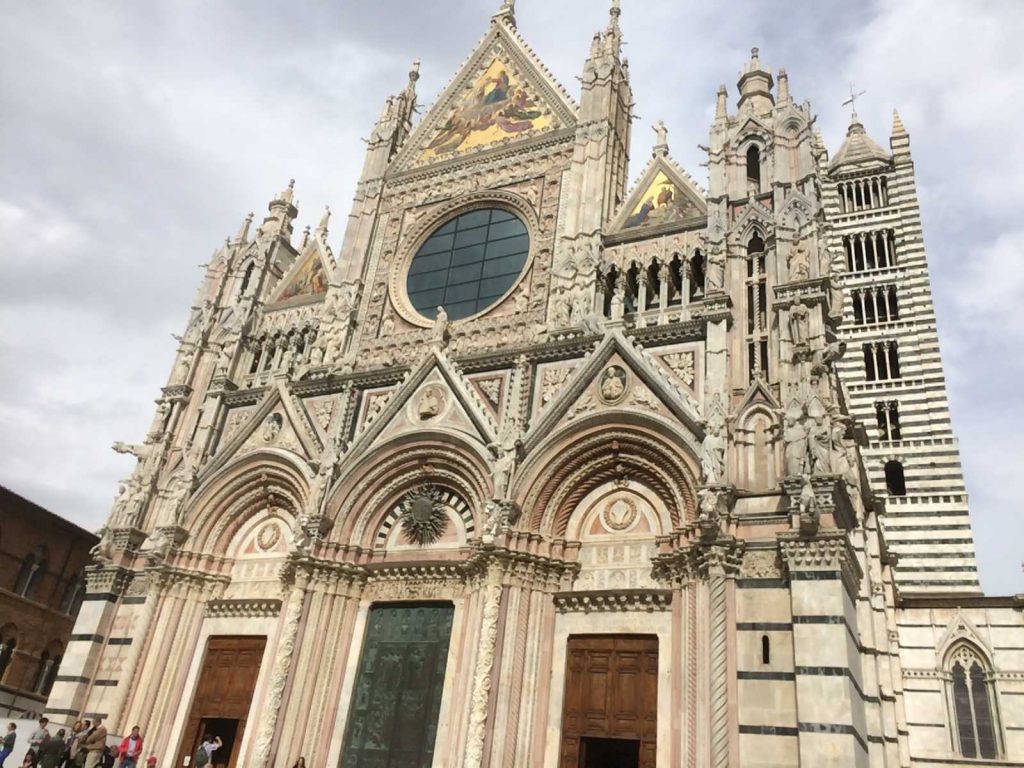Siena is culture and tradition. There cannot be the City of the Palio without all of its history. Nannini has been part of this history since the early twentieth century; with our typical recipes we pass down the culinary tradition of our city from generation to generation We want to bring the name of Siena up high and we think that to savor our recipes with more taste it is also necessary to know Siena, in all its facets.

Siena Cathedral: The exterior
The Duomo of Siena is located in the heart of the city center. Located in the square of the same name, it shows itself in all its beauty and might. Characterized by an Italian Roman-Gothic style, the Duomo is made up of the central building of the cathedral with its dome, bell tower, baptistery and the “Facciatone”.
The structure is erected on a Latin cross plan with three naves. The exterior is instead characterized by the presence of alternating bands of white, carrara marble, and black / greenish bands of serpentine marble from the lawn. In this way the reference to the balzana, the historic coat of arms of Siena, is evident.
According to tradition, the Cathedral of Santa Maria Assunta was built in the XNUMXth century. to replace another church dedicated to Mary. Again according to tradition, it was later consecrated by the Sienese pope Alessandro III Bandinelli.

Already in 1264 the cathedral and the bell tower were built. In 1317 the extension works of the cathedral began towards Via Vallepiatta and the Baptistery. In 1339 the Sienese decided that this building was not enough and therefore it was necessary to expand it to give life to an even larger complex. Accomplice of this thought, the rivalry with nearby Florence and its Santa Maria del Fiore.
Unfortunately the project was never completed due to the plague of 1348 which left Siena in a deep economic crisis. Furthermore, the poor holding of the ground did not allow to host a work of this size. What should have been the "New Cathedral" has therefore never seen the light. What remains of it is the so-called “Facciatone”, nothing more than a skeleton with pillars and a facade. The upper part of the “Facciatone” can be visited and offers a wonderful panoramic view of the city of the Palio.
Siena Cathedral: the floor
If the outside were not enough, the Cathedral of Siena hides other wonders inside. The symmetrical geometry of the external white and black / greenish bands is also maintained inside where it is possible to admire sculptures created by the hands of some of the most important sculptors of every era. Just to name a few we find Nicola Pisano, Donatello and Michelangelo.
Entering the Cathedral of Santa Maria Assunta you can't help but notice the floor. This work is a hymn to beauty. Consisting of 56 marble squares, it was built over the centuries. The project began in the 300th century and finished in the 800th century thanks to the intervention of various artists from Siena, except for the Umbrian Pinturicchio. The techniques used to finish this masterpiece are marble salesman and graffiti.
Giorgio vasari himself was fascinated by this work, defining it as the most beautiful and magnificent that ever existed.
"The most beautiful ..., great and magnificent ... that had ever been made".Giorgio Vasari
To fully appreciate the magnificent beauty of the Cathedral of Siena, there is the path "the door of heaven" which allows you to see the wonders inside and outside the church from a different view.
With this path it is possible to get to the top of the factory and to check above the starry vaults. This way you can enjoy fantastic views both inside and outside the cathedral. These places were closed to the public for a long time and only the master architects could enter.
Siena Cathedral: Piccolomini Library
The Cathedral of Santa Maria Assunta is also the guardian of the small jewel of the Piccolomini Library, which is a work within the work. In this place there is a cycle of frescoes of great pictorial quality by Pinturicchio representing ten episodes from the life of Pope Pius II.
This extremely rich space was desired by Cardinal Francesco Todeschini Piccolomini, archbishop of Siena who later became Pope Pius III, in memory of his maternal uncle Pope Pius II. it is located along the north-western side of the Cathedral where the old rectory was located.
The library is home to the series of manuscripts collected by Pope Pius II surrounded by frescoes painted in Pinturicchio's workshop in the years 1503-1508. Bright colors and a refined technique characterize these painted walls.
The theme of this series recounts the salient moments in the pope's life, such as when he received the office of cardinal or that of pope. A fresco of particular importance is also the one depicting the meeting between Emperor Frederick III and Eleonora of Portugal, favored precisely by Pope Pius II. The facts are painted in strict historical succession and with an infinitesimal attention to detail.
At the center of the vault we can also find the symbol of the Piccolomini family. The room is then finished by the presence of a sculpture depicting the Three Graces, also commissioned by Pope Pius III and bought by the cardinal of Rome.
The Cathedral of Siena is of an ethereal beauty and deserves to be observed in every centimeter. Every corner of this place has been designed to be adorned with immeasurable beauty. Talking about it doesn't do it justice. Seeing it with your own eyes is the only way to grasp its true essence.
A tour of the Cathedral of Santa Maria Assunta takes time and after an intense immersion in its history, a little refreshment in another typical place of Sienese life can help. Come and enjoy yourself a caffè o a sweet in one of our Nannini bars, we are waiting for you to tell you about our Siena.

